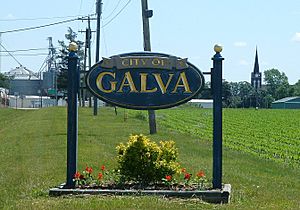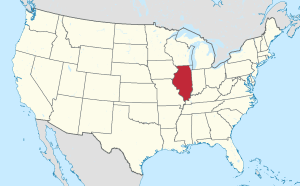Galva, Illinois facts for kids
Quick facts for kids
Galva
|
|
|---|---|
 |
|
| Nickname(s):
City of Go
|
|

Location of Galva in Henry County, Illinois.
|
|

Location of Illinois in the United States
|
|
| Country | United States |
| State | Illinois |
| County | Henry |
| Area | |
| • Total | 2.75 sq mi (7.13 km2) |
| • Land | 2.75 sq mi (7.13 km2) |
| • Water | 0.00 sq mi (0.00 km2) |
| Elevation | 850 ft (260 m) |
| Population
(2020)
|
|
| • Total | 2,470 |
| • Density | 896.55/sq mi (346.18/km2) |
| Time zone | UTC-6 (CST) |
| • Summer (DST) | UTC-5 (CDT) |
| ZIP Code(s) |
61434
|
| Area code(s) | 309 |
| FIPS code | 17-28430 |
| Wikimedia Commons | Galva, Illinois |
Galva is a city in Henry County, Illinois, United States. The population was 2,470 at the 2020 census.
Contents
History
Cousins William L. Wiley (1820–1900) and James Wiley (1817–1886) founded Galva in 1854. The name Galva honors the Swedish immigrants of nearby Bishop Hill and refers to Gävle, Sweden which is the town's sister city. Today around 80% of the town has Scandinavian ancestry.
Galva was a railroad town. Galva was laid out along the Chicago, Burlington and Quincy Railroad (Burlington Route) with the help of Bishop Hill trustees who invested heavily in Galva. This was the first of three rail lines to locate there. This group was formed in 1852 and ran a line from Aurora, Illinois to Galesburg, Illinois. A second branch of the Burlington Route later also came through. Later the Peoria and Rock Island Railroad (Rock Island Railroad) came through Galva. Several Amtrak lines run through the town, including the California Zephyr and Southwest Chief, but none stop in Galva. A station is located 10 miles north in Kewanee for the Illinois Zephyr and Carl Sandburg, and 25 miles south in Galesburg for all trains.
Geography
According to the 2021 census gazetteer files, Galva has a total area of 2.76 square miles (7.15 km2), all land.
Climate
| Climate data for Galva, Illinois (1991–2020 normals, extremes 1887–present) | |||||||||||||
|---|---|---|---|---|---|---|---|---|---|---|---|---|---|
| Month | Jan | Feb | Mar | Apr | May | Jun | Jul | Aug | Sep | Oct | Nov | Dec | Year |
| Record high °F (°C) | 67 (19) |
71 (22) |
86 (30) |
93 (34) |
105 (41) |
105 (41) |
111 (44) |
105 (41) |
101 (38) |
93 (34) |
83 (28) |
69 (21) |
111 (44) |
| Mean daily maximum °F (°C) | 30.0 (−1.1) |
35.1 (1.7) |
48.2 (9.0) |
61.4 (16.3) |
72.6 (22.6) |
81.5 (27.5) |
84.1 (28.9) |
82.3 (27.9) |
76.5 (24.7) |
63.8 (17.7) |
48.3 (9.1) |
35.7 (2.1) |
60.0 (15.6) |
| Daily mean °F (°C) | 21.5 (−5.8) |
26.0 (−3.3) |
37.7 (3.2) |
49.6 (9.8) |
61.4 (16.3) |
70.6 (21.4) |
73.5 (23.1) |
71.2 (21.8) |
64.0 (17.8) |
52.1 (11.2) |
38.6 (3.7) |
27.3 (−2.6) |
49.5 (9.7) |
| Mean daily minimum °F (°C) | 12.9 (−10.6) |
16.8 (−8.4) |
27.2 (−2.7) |
37.8 (3.2) |
50.2 (10.1) |
59.8 (15.4) |
62.9 (17.2) |
60.2 (15.7) |
51.5 (10.8) |
40.3 (4.6) |
28.9 (−1.7) |
18.8 (−7.3) |
38.9 (3.8) |
| Record low °F (°C) | −32 (−36) |
−28 (−33) |
−12 (−24) |
9 (−13) |
22 (−6) |
34 (1) |
44 (7) |
38 (3) |
19 (−7) |
9 (−13) |
−7 (−22) |
−26 (−32) |
−32 (−36) |
| Average precipitation inches (mm) | 1.62 (41) |
1.76 (45) |
2.35 (60) |
4.22 (107) |
4.82 (122) |
5.17 (131) |
3.63 (92) |
3.73 (95) |
3.97 (101) |
2.84 (72) |
2.55 (65) |
2.01 (51) |
38.67 (982) |
| Average precipitation days (≥ 0.01 in) | 4.9 | 5.3 | 8.0 | 10.1 | 10.2 | 10.4 | 7.5 | 7.6 | 7.3 | 7.6 | 7.1 | 5.6 | 91.6 |
| Source: NOAA | |||||||||||||
Demographics
| Historical population | |||
|---|---|---|---|
| Census | Pop. | %± | |
| 1860 | 1,005 | — | |
| 1870 | 2,160 | 114.9% | |
| 1880 | 2,148 | −0.6% | |
| 1890 | 2,409 | 12.2% | |
| 1900 | 2,682 | 11.3% | |
| 1910 | 2,498 | −6.9% | |
| 1920 | 2,974 | 19.1% | |
| 1930 | 2,875 | −3.3% | |
| 1940 | 2,812 | −2.2% | |
| 1950 | 2,886 | 2.6% | |
| 1960 | 3,060 | 6.0% | |
| 1970 | 3,061 | 0.0% | |
| 1980 | 3,185 | 4.1% | |
| 1990 | 2,742 | −13.9% | |
| 2000 | 2,758 | 0.6% | |
| 2010 | 2,589 | −6.1% | |
| 2020 | 2,470 | −4.6% | |
| U.S. Decennial Census | |||
As of the 2020 census there were 2,470 people, 1,148 households, and 683 families residing in the city. The population density was 896.55 inhabitants per square mile (346.16/km2). There were 1,254 housing units at an average density of 455.17 per square mile (175.74/km2). The racial makeup of the city was 93.36% White, 0.93% African American, 0.12% Native American, 0.20% Asian, 0.00% Pacific Islander, 0.36% from other races, and 5.02% from two or more races. Hispanic or Latino of any race were 2.91% of the population.
There were 1,148 households, out of which 23.8% had children under the age of 18 living with them, 46.17% were married couples living together, 11.24% had a female householder with no husband present, and 40.51% were non-families. 39.02% of all households were made up of individuals, and 15.77% had someone living alone who was 65 years of age or older. The average household size was 2.95 and the average family size was 2.21.
The city's age distribution consisted of 23.2% under the age of 18, 4.8% from 18 to 24, 21.4% from 25 to 44, 28.6% from 45 to 64, and 22.0% who were 65 years of age or older. The median age was 46.0 years. For every 100 females, there were 98.4 males. For every 100 females age 18 and over, there were 100.4 males.
The median income for a household in the city was $44,191, and the median income for a family was $65,913. Males had a median income of $44,935 versus $27,288 for females. The per capita income for the city was $25,796. About 14.3% of families and 19.5% of the population were below the poverty line, including 44.3% of those under age 18 and 5.5% of those age 65 or over.
Education
Higher education
Black Hawk College, a community college, has one of its campus in the town.
Community organizations
- Galva Arts Council
- Galva American Legion Post #45
Notable people
- Reuben Beals, Illinois state representative, farmer, and carpenter.
- Rich Falk, professional basketball player.
- Rollin Kirby, a political cartoonist and three-time winner of the Pulitzer Prize.
- Mrs. Wiggins, also known as Carolyn Krans Wiggins, a talented and beautiful W. Illinois University professor of piano pedagogy.
See also
 In Spanish: Galva (Illinois) para niños
In Spanish: Galva (Illinois) para niños

